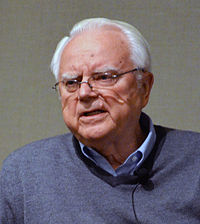
Back Ecuación de Drake AN معادلة دريك Arabic Dreyk tənliyi Azerbaijani Ураўненне Дрэйка Byelorussian Уравнение на Дрейк Bulgarian ড্রেকের সূত্র Bengali/Bangla Drakeova jednačina BS Equació de Drake Catalan Drakeova rovnice Czech Drakes ligning Danish

The Drake equation is a probabilistic argument used to estimate the number of active, communicative extraterrestrial civilizations in the Milky Way Galaxy.[1][2][3]
The equation was formulated in 1961 by Frank Drake, not for purposes of quantifying the number of civilizations, but as a way to stimulate scientific dialogue at the first scientific meeting on the search for extraterrestrial intelligence (SETI).[4][5] The equation summarizes the main concepts which scientists must contemplate when considering the question of other radio-communicative life.[4] It is more properly thought of as an approximation than as a serious attempt to determine a precise number.
Criticism related to the Drake equation focuses not on the equation itself, but on the fact that the estimated values for several of its factors are highly conjectural, the combined multiplicative effect being that the uncertainty associated with any derived value is so large that the equation cannot be used to draw firm conclusions.
- ^ Physics Today 14 (4), 40–46 (1961). Drake, F. D. (April 1961). "Project Ozma". pubs.aip.org. American Institute of Physics. Retrieved 27 April 2023.
The question of the existence of intelligent life elsewhere in space has long fascinated people, but, until recently, has been properly left to the science‐fiction writers.
- ^ Cite error: The named reference
Burchellwas invoked but never defined (see the help page). - ^ Glade, N.; Ballet, P.; Bastien, O. (2012). "A stochastic process approach of the drake equation parameters". International Journal of Astrobiology. 11 (2): 103–108. arXiv:1112.1506. Bibcode:2012IJAsB..11..103G. doi:10.1017/S1473550411000413. S2CID 119250730.
- ^ a b "Chapter 3 – Philosophy: "Solving the Drake Equation". Ask Dr. SETI. SETI League. December 2002. Retrieved 10 April 2013.
- ^ Drake, N. (30 June 2014). "How my Dad's Equation Sparked the Search for Extraterrestrial Intelligence". National Geographic. Archived from the original on 5 July 2014. Retrieved 2 October 2016.